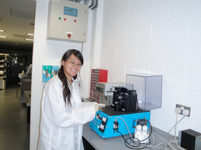
University:
Major:
Site Abroad:
Mentor(s):
Faculty Sponsor(s):
Project Title:
Project Description:
The primary use of liquid crystals is in modern liquid crystal displays (LCD) in computer monitors, televisions, video players, gaming devices, clocks, watches, calculators, and telephones. Liquid crystalline displays replaces the cathode ray tubes (CRT), electroluminescence devices, plasma display systems, field emission devices, flat CRT, vacuum florescence etc. The most common structure used in LCD monitors today is the twisted nematic liquid crystal structure. Researching the properties of the twisted nematic liquid crystal displays can give an understanding how it functions, giving insight on designing an optimal display to improve functionality for a particular liquid crystal material. Liquid crystal is a state between crystalline solid and liquid. The specific liquid crystal material chosen is called 4-heptyl-4’–cyanbiphenyl (7CB). Liquid crystal has anisotropic physical properties that allow the materials to change under external forces like electric and magnetic fields, which are essential for technological applications. Other properties that are effected by anisotropic materials are dielectrics, which are electrical insulators polarized by an applied electric field. Designing an optimal display, the components of a LCD are necessary, which includes the liquid crystal sandwiched between two glass plates with a layer of transparent electrodes (Indium Tin Oxide) on each plate. Applying a voltage across the electrodes, the electric field inside the display can be obtained to control the transmission of light through the liquid crystal cell. Based on the design of the display, the response time and the contrast ratio (brightness) can improve.
